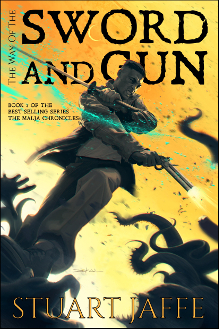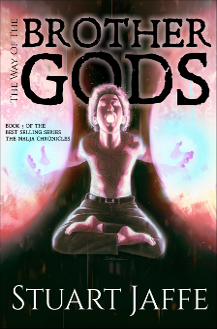Stuart Jaffe's Blog, page 5
January 23, 2014
Why Now? 5 Reasons That Science Fiction is on the Rise
 Look around you…on the train or bus, at cafes and bars—people everywhere seem to be reading some variant of Science Fiction. As a genre, Science Fiction has been around for some time. Mary Shelley’s Frankenstein is cited by most as the first Science Fiction novel ever. And in the 1930s, H.G. Wells was writing predictions for the future. But, today, add the emergence of newer similar genres like Paranormal, Dystopian, or Post-Apocalyptic Fantasy fiction, and it’s easy for readers to get things confused. These are all forms of what’s called Speculative fiction. And all of them are growing in popularity all of the time giving Science Fiction a unique vitality and energy as an evolving art form.
Look around you…on the train or bus, at cafes and bars—people everywhere seem to be reading some variant of Science Fiction. As a genre, Science Fiction has been around for some time. Mary Shelley’s Frankenstein is cited by most as the first Science Fiction novel ever. And in the 1930s, H.G. Wells was writing predictions for the future. But, today, add the emergence of newer similar genres like Paranormal, Dystopian, or Post-Apocalyptic Fantasy fiction, and it’s easy for readers to get things confused. These are all forms of what’s called Speculative fiction. And all of them are growing in popularity all of the time giving Science Fiction a unique vitality and energy as an evolving art form.
If you look up Science Fiction in Wikipedia, here’s what you’ll learn:
“Science Fiction is a genre of fiction dealing with imaginative content such as futuristic settings, futuristic science and technology, space travel, time travel, parallel universes, and extraterrestrial life. Exploring the consequences of scientific innovations is one purpose of science fiction, making it a ‘literature of ideas.’ Science fiction has been used by authors as a device to discuss philosophical ideas such as identity, desire, morality, and social structure.” I would add that, for me, the best Science Fiction is inherently optimistic in nature taking a positive view of both technology and humanity.
The Future is Now – 5 Reasons People Love Science Fiction
But, the question remains: Why now? Why, in 2014, do readers make the choice to read a Science Fiction book above any other? I’ve got a few ideas.
– We’re living in Science Fiction. The world in which we live, in many ways, is the manifestation of that imagined by early Science Fiction writers. For example, in his 1933 book, Men Like Gods, H. G. Wells envisioned an “answerphone,” in which people leave voice messages that the recipients can listen to when they choose. Decades later, the answering machine was born. Science fiction is always as much about the present day as it is about the future. We need it to help us understand and make sense of the world we live in.
– Technology is accelerating more rapidly than at any time in human history—faster than the average human brain can comprehend. So much good has come out of technology…I’d probably still be sitting at my desk trying to get a novel published if it weren’t for the advances in digital publishing technology. However, people feel considerable anxiety about technology getting out of control or being used for malevolent purposes. The message of many classic Science Fiction works is that we can overcome. Human actors always prevail over technology. Science fiction provides comfort in a highly technological era.
– It’s exciting and entertaining to read about the amazing inventions that you imagined as a kid—things like tourism on the moon, communicating through the television, or even holograms, or satellites orbiting the earth possibly coming to fruition. In 1945, Arthur C. Clarke proposed earth-orbiting satellites, 20 years before the first actual one was launched. Science Fiction appeals to your imagination, your sense of wonder at the capabilities of technology and of humans who created it. Despite the closings at NASA, the American fascination with space travel and cosmic investigation is stronger than ever. Science Fiction represents an artistic expression of this technology and it’s thrilling to read.
– Thanks to the non-stop news cycle—on radio, television, and the Internet—we have access to more information from across the globe than ever before. More knowledge is a good thing; but, unfortunately, much of this news is not good. Constantly hearing about the atrocities overseas, terrorism abroad, or school shootings here at home has put us on edge. As advanced as technology has become and as seamlessly integrated it may be into our American lives, there are still parts of our world that feel primitive, frightening, and dangerous. Science Fiction provides an escape from the tragic realities of modern life, but it also gives us hope that we will survive and find a way to solve these global problems.
– Never before have Science Fiction stories been rendered so believably in film. Before the development of CGI, or computer-generated-imagery, it was impossible to create a realistic visual representation of Science Fiction—making many of these tales impossible to share on film. In fact, early movies about the future looked rather hokey with silly flying saucers and aliens that may as well be made of tin foil (and probably were!). But, with the release of the epic space opera Star Wars in 1977, George Lucas went leaps and bounds ahead of what anyone else was doing. And he didn’t have CGI at the time. Later, CGI came along and has forever changed the way that Science Fiction stories can be told, offering spectacular special effects and mind-blowing visuals. A whole new audience of moviegoers is attracted to the genre—that audience has translated into more readers of Science Fiction as well.
So, why Science Fiction now? You tell me.
What compels you to pick up a work of Science Fiction these days? Or, have you always been a Sci-Fi geek? I’d especially like to hear from new readers of the genre—what caused you to go cosmic?
The post Why Now? 5 Reasons That Science Fiction is on the Rise appeared first on Stuart Jaffe.
January 16, 2014
The Importance of Laughing: Humor in Fantasy Fiction
Mark Twain wrote, “the human race has one really effective weapon, and that is laughter.” Now, I don’t know that he had fantasy fiction in mind when he penned those words, however it certainly helps to have a good sense of humor when the world as you know it is collapsing around you. Putting humor in fantasy fiction may not be the first thing that comes to your mind when you think about Urban Fantasy or Post-Apocalyptic fiction, but the narrative rarely succeeds without it—and in a precarious world, you need to employ every weapon in your arsenal.
Don’t believe me? Think about the quintessential Urban Fantasy television program about that cheerleader-turned-slayer Buffy, The Vampire Slayer. The series could be classified as a comedy in many ways—I can’t think of any episodes that don’t include comic elements– yet I can think of a few that are slim on the drama side. Without laughter, I doubt Buffy would have been such a successful show with an endless supply of loyal fans to this day.
What’s So Funny About the End of the World?
Not much…so, you may as well laugh. What’s the alternative? Hide in a burned-out car and cry? Wait in despair for the Zombies to eat your flesh? Neither strategy sounds like they’d accomplish much, and it sure wouldn’t be too entertaining to read about. For me, the point of telling a story that is set in a dark and hopeless world is to highlight the triumph of humanity in the face of some serious adversity. For this to work, the characters must experience a release, or catharsis, of some sort. Often, a comedic character or dark humor provides just such a release.
Or, you could go the Cormac McCarthy route, as in his classic Post-Apocalyptic tale The Road, and take readers on a trip through a desolate landscape that really goes nowhere except from bleak to bleaker. The novel starts out dark and hopeless and McCarthy doesn’t let up over the course of the story. The characters—and readers as well—experience no release and by book’s end probably wish they could pop a Xanax or simply end it all on the spot. Not my idea of a good story. Laughter is a far more pleasurable response.
Laughter Really Is a Powerful Weapon in a Dangerous World
You’ve heard the saying, “Laughter is the best medicine”? Well, there’s plenty of science to back that up. Laughter is a powerful antidote to stress, pain, and conflict—all benefits that are extremely helpful in a Post-Apocalyptic Fantasy world. Nothing works faster or more dependably to bring your mind and body back into balance than a good laugh.
Characters like Fawbry, from The Malja Chronicles, use humor to lighten the mood, ease fear, inspire hope, and help their group feel connected to one another. Even when it’s sarcastic humor at their own expense. For example, in The Way of the Brother Gods (Book 3 of The Malja Chronicles), Malja, Tommy, and Fawbry are find themselves in a desolate town. Malja wants to split off to recon the area. To Fawbry she says:
“… grab Tommy and use those stairs to get out. And scream. This town isn’t that big and everything’s quiet. You scream, I’ll hear it.”
“Don’t worry. I can scream loud,” Fawbry said
It’s just a small throwaway line, but it lightens the mood for a second — even as the darkness of the idea sinks things deeper. It’s similar to the kind of humor that peeks out momentarily in Schindler’s List — humor that is essential to being able to sit through such a traumatic experience.
When I first wrote Fawbry his job was essentially to provide those slivers of humor. He was comic relief. I thought I’d kill him off after the first book of the series, The Way of the Black Beast. But as he evolved, I realized that he is integral to the story in the same way that the double-speaking Fool is critical to Shakespeare’s tragedy King Lear. And many of my fans cite Fawbry among their favorite characters so I’m glad I kept him around. His lighthearted antics in the face of intense battle and overwhelming odds provide the catharsis that all of the other characters need for their very survival—that’s no laughing matter.
Let’s Share Some Laughs
Have you ever used laughter as a weapon like Twain suggests? Do you like your Fantasy or Post-Apocalyptic fiction with a healthy dose of chuckles? Please share some literary laughs with me, folks. Who doesn’t love a good laugh?
The post The Importance of Laughing: Humor in Fantasy Fiction appeared first on Stuart Jaffe.
January 9, 2014
More Than Meets The Eye: The Setting As Character in Paranormal and Fantasy Fiction
In any work of fiction, the author’s choice of setting establishes some basic information—its historical, geographical, and physical context, for example. The where, the when, the what was the weather like, etc. Setting, however, is more than simply the approximate time and place in which a work is set.
When written well, setting can provide an endless source of details that help make a story more vivid for readers as well as provide new ideas and inspiration for the writer. Generally speaking, books in which the setting is skillfully presented are better books because of it.
One Big Set Up
Where a story takes place—the American South, on a crowded elevator, on a cruise ship or, perhaps, in the belly of a dragon—influences the behaviors of the characters as well as the readers’ reactions to the story’s events. When a work takes place—during the Vietnam War, at the turn of the twentieth-century, “a long, long time ago”, today, or far in the future—is equally important. Post-modern author Nicholson Baker wrote an entire novel, The Mezzanine, taking place during a man’s lunchtime trip up an escalator of the office building where he is employed. So, you see, setting can provide fodder for much more than meets the eye.
Setting as Character in the Horror Story
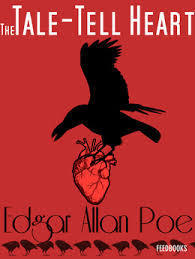 Clearly, setting is more important in some works than others. It can work as a reflection of the characters. It acts on the characters. And, in some cases, setting acts as almost a character itself. Edgar Allen Poe was masterful at using physical setting to chilling effect in his gothic tales. Poe’s story of a gruesome murder, The Tell-Tale Heart, occurs in an unorthodox place: a mysterious, rather amorphous, mansion (something that’s become a bit cliché, but at the time was rather new). It also begins in the dark of night, reinforcing the dark mood.
Clearly, setting is more important in some works than others. It can work as a reflection of the characters. It acts on the characters. And, in some cases, setting acts as almost a character itself. Edgar Allen Poe was masterful at using physical setting to chilling effect in his gothic tales. Poe’s story of a gruesome murder, The Tell-Tale Heart, occurs in an unorthodox place: a mysterious, rather amorphous, mansion (something that’s become a bit cliché, but at the time was rather new). It also begins in the dark of night, reinforcing the dark mood.
However, Poe doesn’t stop there, he goes so far as to give the old house a heartbeat of its own. The main character, whose name we don’t know, is not certain if the heartbeat that he hears is his own, that of the old man he has just murdered and subsequently dismembered, or, if perhaps the house itself has a beating heart. In this terrifying tale, the setting acts almost as the conscience of the main character. The Tell-Tale Heart could not happen anywhere else or at any other time imaginable. That, folks, is setting as character.
Setting and the Paranormal
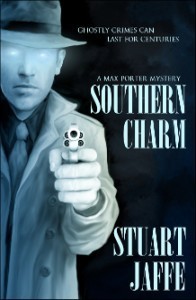 In the three novels in my Max Porter paranormal mystery series—Southern Bound, Southern Charm, and Southern Belle—setting plays a key role in both story and character development. At series beginning, Max Porter has just changed settings himself. He and his wife, Sandra, have relocated from Michigan to North Carolina, hoping for a fresh start in a new place, with a new home, in a new job.
In the three novels in my Max Porter paranormal mystery series—Southern Bound, Southern Charm, and Southern Belle—setting plays a key role in both story and character development. At series beginning, Max Porter has just changed settings himself. He and his wife, Sandra, have relocated from Michigan to North Carolina, hoping for a fresh start in a new place, with a new home, in a new job.
Max Porter was trying to escape the past, his former setting, and a different kind of past comes after him in Winston-Salem, North Carolina. The old building, which houses his new office, is haunted by a 1940s detective. As a result, Max finds himself thrust neck-deep in a world of old mysteries and dangerous enemies. Setting is critical in my Max Porter books because the history of Winston-Salem (and later, much of North Carolina) has direct influence on the characters and stories. These stories can’t happen without it and wouldn’t happen any place else.
Character Versus Setting in Fantasy and Dystopian Novels
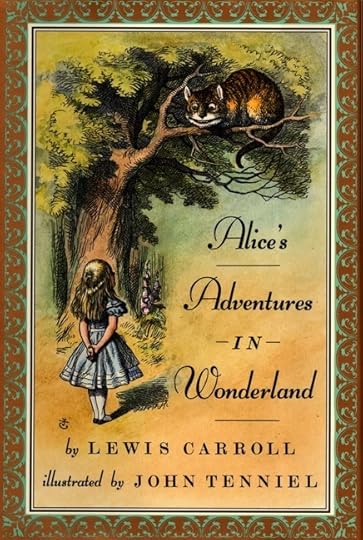 Sometimes a story’s central conflict is between the protagonist and the setting—for example, in the fantasy classic Alice in Wonderland, the setting “down the rabbit hole” drives the story’s plot. Alice is, in many ways, an intruder in a magical universe with social mores and logic of its own (or lack thereof) that she cannot understand or predict. In fact, much of the tale involves her “learning” the rules of this new world (see also, The Wizard of Oz and Gulliver’s Travels). In this case, the setting—and Alice’s reactions to it—helps define for readers who Alice is as a character.
Sometimes a story’s central conflict is between the protagonist and the setting—for example, in the fantasy classic Alice in Wonderland, the setting “down the rabbit hole” drives the story’s plot. Alice is, in many ways, an intruder in a magical universe with social mores and logic of its own (or lack thereof) that she cannot understand or predict. In fact, much of the tale involves her “learning” the rules of this new world (see also, The Wizard of Oz and Gulliver’s Travels). In this case, the setting—and Alice’s reactions to it—helps define for readers who Alice is as a character.
Like Alice, for Malja, the heroine of my post-apocalyptic fantasy series, The Malja Chronicles, the setting provides a primary source of conflict. While the setting of any novel is important, the setting for a dystopian novel is key. It is, after all, the changing world, or setting, that makes a post-apocalyptic novel really, well, post-apocalyptic. A dystopian setting that provides the main character with a chance to rise above the dark world and triumph is highly effective.
Remember, setting doesn’t simply include time and place, but also the society and societal expectations. Does the world expect your character to be a slave or a hero? For Malja, there’s no question. She’s not just a heroine. She’s a kickass heroine to boot. She has to be to survive in the dystopian parallel universe of Corlin…and wherever she finds herself next.
What’s Your Setting of Choice?
Have you read any stories with great settings that are more than meets the eye? Have you visited any fictional landscapes that you’ll never forget? I’d love to hear about some of your favorite settings, whatever the genre.
The post More Than Meets The Eye: The Setting As Character in Paranormal and Fantasy Fiction appeared first on Stuart Jaffe.
January 2, 2014
Kickass Heroines in Film and How They Have Influenced My Urban Fantasy Writing
Now that I’m back at work on my second Gillian Boone novel, I’ve been thinking about some of the great kickass heroines from film that have helped shape my characterization of her. I’ve also noticed how almost every Urban Fantasy book cover depicts a woman with a menacing scowl, wearing bondage-inspired clothing, while clutching some kind of sword or saber-like weaponry. Just indulge for a moment and you’ll see where I’m headed.
Hey, I love the idea of sexy and strong kickass heroines. But, for my money, I’ll take the everyday female fictional character who finds herself in an extraordinary situation and, not only rises to the occasion, but prevails. They tend to possess a depth of character that is absent from the more warrior princess variety of heroines. Some classic heroines from Science-Fiction film possess multidimensional characteristics as well as raw power – that’s what makes them so kick-ass. Here are a few of my favorites.
Cinematic Heroines Who Kick Ass and Take Names
Ripley, played by Sigourney Weaver appeared in Alien (1979), Aliens (1986), Alien 3 (1992), Alien: Resurrection (1997)
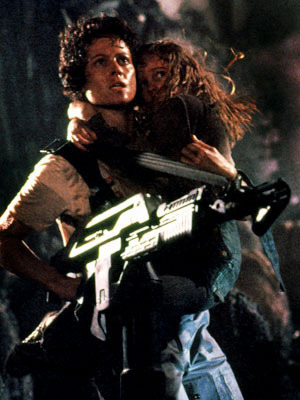 Few sci-fi films scare the heck out of you as much as Alien. And none of them have Ellen Ripley, a kickass heroine who remains one of the greatest figures in film of any genre. One of the first real female action heroes, Ripley kicks some serious extra-terrestrial ass in the four Alien movies. One of the qualities that make her so believable in this role is her humanity, her palpable sense of real terror. Any one of us would be terrified with hideous, salivating aliens within arm’s reach who have every intention of sucking you up whole or using your body as an incubator for their young. But, Ripley makes you feel it, hear it, and taste it along with her.
Few sci-fi films scare the heck out of you as much as Alien. And none of them have Ellen Ripley, a kickass heroine who remains one of the greatest figures in film of any genre. One of the first real female action heroes, Ripley kicks some serious extra-terrestrial ass in the four Alien movies. One of the qualities that make her so believable in this role is her humanity, her palpable sense of real terror. Any one of us would be terrified with hideous, salivating aliens within arm’s reach who have every intention of sucking you up whole or using your body as an incubator for their young. But, Ripley makes you feel it, hear it, and taste it along with her.
The badass Ripley makes out like a champ and then goes back for more—four times. As traumatized as she was by her first alien encounter, she was also so haunted by the experience that she has to go back in. In order to get her life back, she has to face her fears and conquer them, even if that means coming face to acid-spewing face with one of the most grotesque monsters in film. Pure guts. Pure glory.
Sarah Conner, played by Linda Hamilton, appeared in The Terminator (1984), Terminator 2: Judgement Day (1991)
 Sarah Conner is the perfect example of the girl-next-door who turns fiercely kickass. When we first meet her, she’s working for tips as a waitress, yet she’s supposed to be the mother of the guy who saves humanity? When push comes to shove, Sarah Conner finds it within her to do whatever it takes. Sarah Conner is clearly an ass-kicker; I mean, she crushes Arnold in a metal press.
Sarah Conner is the perfect example of the girl-next-door who turns fiercely kickass. When we first meet her, she’s working for tips as a waitress, yet she’s supposed to be the mother of the guy who saves humanity? When push comes to shove, Sarah Conner finds it within her to do whatever it takes. Sarah Conner is clearly an ass-kicker; I mean, she crushes Arnold in a metal press.
But what makes her a fantastic sci-fi hero is the fact that she’s a mother first.
Sarah Conner transforms herself into a warrior for the sake of her son, to prepare him for the future. Even when her own child thinks she is spiraling down into insanity, she perseveres. Ultimately, Sarah Conner is a mother at war with the future. And, she’s winning it.
Katniss, played by Jennifer Lawrence appeared in The Hunger Games (2012) and The Hunger Games: Catching Fire (2014)
 When we are introduced to Katniss, she is a young woman, with almost no support system or resources, who manages to care for herself and her family with few complaints. That is an accomplishment in itself. But when she’s thrust into the kill-or-be-killed world of the Hunger Games—by selflessly volunteering to save her little sister—all bets are off. Katniss taps into her inner badass and transforms herself into a kickass warrior and unstoppable force.
When we are introduced to Katniss, she is a young woman, with almost no support system or resources, who manages to care for herself and her family with few complaints. That is an accomplishment in itself. But when she’s thrust into the kill-or-be-killed world of the Hunger Games—by selflessly volunteering to save her little sister—all bets are off. Katniss taps into her inner badass and transforms herself into a kickass warrior and unstoppable force.
Throughout the series, we identify with her attempts to discern right from wrong, decide who she can trust and who is lying. As extreme as her circumstances are, Katniss still wrestles with challenges that resonate with our everyday lives. And, while her humanity is celebrated it is often not immediately rewarded. Katniss does all of this while being human, it’s kickass but it’s also inspiring.
More Gillian Kicking-Butt in the New Year
The second novel in my Gillian Boone Urban Fantasy series novel is moving along now that the holidays are over. As I get back into the swing of things, the story is kicking along fine. And Gillian is growing into a kickass heroine all her own. Like many of the women above, Gillian started out as a normal, everyday gal (as far as she knew) who was then thrown into bizarre circumstances. Writing the second book has the challenge that all of these characters faced – how to deal with the world now that the harsh reality has been revealed, that the curtain has been pulled back. Of course, since I’m focusing here on kickass women, you can imagine, Gillian won’t be backing down.
Best of all, cover artist Renu Sharma has agreed to do the second cover. She did such an amazing job with A Glimpse of Her Soul and I know she’ll do great with this next book, too. For now, we’ll have to wait and see how the cover stacks up to other Urban Fantasy fiction covers out there – I know you won’t be disappointed.
Have any favorite kickass heroines of your own?
This list of kickass female characters is in no way intended to be definitive or complete. Who are some of your favorite ass-kicking heroines, and why? I’d like to know.
The post Kickass Heroines in Film and How They Have Influenced My Urban Fantasy Writing appeared first on Stuart Jaffe.
December 28, 2013
Have a PA-Fantasy New Year’s Eve
5-4-3-2-1…Happy Post-Apocalyptic Fantasy New Year!
 There were no Zombies. There was no nuclear war. It wasn’t global warming, or a pandemic. But it was still a post-apocalyptic fantasy Christmas for us. As a family—and that’s how we operate—my characters and I have survived several pre- and post-apocalyptic holidays together. But this 2013 holiday season, with all of its shiny wrappings and tinseled trappings and despite its lack of undead zappings was among the most cataclysmic of happenings…So, be vigilant 2014, the apocalypse is always just one flap of a butterfly’s wings away from a portal to all-out chaos.
There were no Zombies. There was no nuclear war. It wasn’t global warming, or a pandemic. But it was still a post-apocalyptic fantasy Christmas for us. As a family—and that’s how we operate—my characters and I have survived several pre- and post-apocalyptic holidays together. But this 2013 holiday season, with all of its shiny wrappings and tinseled trappings and despite its lack of undead zappings was among the most cataclysmic of happenings…So, be vigilant 2014, the apocalypse is always just one flap of a butterfly’s wings away from a portal to all-out chaos.
The Jaffe Family Retrospective –
Ring in the New Year, Series by Series
Of course, each of my characters will ring in the New Year in their own way, in their own world, and with varying degrees of optimism, resignation, vengeance and mixed emotions. Here are some of the evolutions and resolutions that you have to look forward to from the Jaffe clan as they celebrate the year’s end and look forward to the next.
The Malja Chronicles Crew
 New Year’s Eve festivities rank pretty low on Malja’s list of priorities. Vengeance is her game. She doesn’t put too much stock in resolutions—no matter what time of the year. If she makes any resolution at all, it is simply to kill less people than she did the year before. As her time on Corlin comes to a close, I see her on the precipice of still another odyssey, strategizing her next move. A continued quest for “Gates” is in order so I see travel in Malja’s future – a lot of travel to some not-so-friendly destinations. Of course, she spends New Year’s Eve with Tommy and Fawbry who provide light and laughs, respectively. Tommy’s magic light show is a big hit, while Fawbry strikes out with each attempt to trap an unsuspecting female into a New Year’s kiss. Some things never change…no matter what the universe.
New Year’s Eve festivities rank pretty low on Malja’s list of priorities. Vengeance is her game. She doesn’t put too much stock in resolutions—no matter what time of the year. If she makes any resolution at all, it is simply to kill less people than she did the year before. As her time on Corlin comes to a close, I see her on the precipice of still another odyssey, strategizing her next move. A continued quest for “Gates” is in order so I see travel in Malja’s future – a lot of travel to some not-so-friendly destinations. Of course, she spends New Year’s Eve with Tommy and Fawbry who provide light and laughs, respectively. Tommy’s magic light show is a big hit, while Fawbry strikes out with each attempt to trap an unsuspecting female into a New Year’s kiss. Some things never change…no matter what the universe.
The Max Porter Paranormal Series
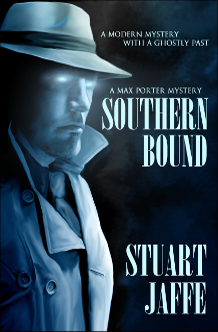 Max and his wife Sandra would like nothing more than to spend a romantic New Year’s Eve, just the two of them, perhaps toasting to their future together and sharing a kiss when the clock strikes midnight. They seem to get so little time to be really alone. For once, it would be nice to have no one come to visit—from family members to those of a paranormal nature. But, the Porters would have no such luck this year. Max’s mother, who had arrived well before Christmas, shows no signs of packing up her bags anytime soon. And their mischievous ghost, Drummond, gets a quite a kick out of turning their New Year’s Eve into a French farce…So, there’s no Bon Annee for Max and Sandra. Maybe next year?
Max and his wife Sandra would like nothing more than to spend a romantic New Year’s Eve, just the two of them, perhaps toasting to their future together and sharing a kiss when the clock strikes midnight. They seem to get so little time to be really alone. For once, it would be nice to have no one come to visit—from family members to those of a paranormal nature. But, the Porters would have no such luck this year. Max’s mother, who had arrived well before Christmas, shows no signs of packing up her bags anytime soon. And their mischievous ghost, Drummond, gets a quite a kick out of turning their New Year’s Eve into a French farce…So, there’s no Bon Annee for Max and Sandra. Maybe next year?
The Gillian Boone Series
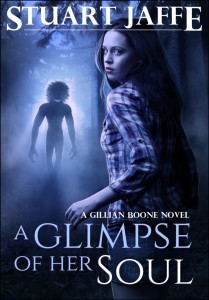 Ever since 16-year-old Gillian Boone discovered that a secret message was etched into her soul, her hopes of leading a ‘normal’ teenage life were dashed. So after a year of running for her life while fighting off Callers – bizarre monstrosities trying to kill her so they can read the message as her soul departs – all she wants is to spend a quiet and traditional New Year’s Eve with Pops. Maybe stay up until midnight and watch the ball drop in Times Square. But Callers never want to let her be for long. At least she has the help of a rogue Caller, Jackhammer Jack, to fight alongside her. It doesn’t look like she’s going to get a reprieve from the magic, mystery and mayhem in the New Year either. For Gillian, the excitement is just getting started.
Ever since 16-year-old Gillian Boone discovered that a secret message was etched into her soul, her hopes of leading a ‘normal’ teenage life were dashed. So after a year of running for her life while fighting off Callers – bizarre monstrosities trying to kill her so they can read the message as her soul departs – all she wants is to spend a quiet and traditional New Year’s Eve with Pops. Maybe stay up until midnight and watch the ball drop in Times Square. But Callers never want to let her be for long. At least she has the help of a rogue Caller, Jackhammer Jack, to fight alongside her. It doesn’t look like she’s going to get a reprieve from the magic, mystery and mayhem in the New Year either. For Gillian, the excitement is just getting started.
The Bluesman
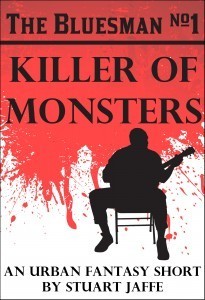 The Bluesman Fuller loves nights like New Year’s Eve. Thrown into our world from a parallel universe, any reason for celebration trumps the post-apocalyptic nightmare he came from. Especially since the same magic that brought him to our world also brought along numerous baddies from his. He wants to save the Earth from being overrun by these horrid, mutated creatures, but that doesn’t stop him from having a good time along the way. Armed with magic, music, and his companion, Scotch, he faces down these monsters all year long hoping to create a peaceful world for all. He figures that he and his buddy should enjoy a well-deserved night on the town and stumble into the first cheesy dive bar they see. The lonely barflies don’t know what hit them. The Bluesman wails on his guitar giving them a night they’ll never forget…or, can’t remember. Either way, it’s a win-win.
The Bluesman Fuller loves nights like New Year’s Eve. Thrown into our world from a parallel universe, any reason for celebration trumps the post-apocalyptic nightmare he came from. Especially since the same magic that brought him to our world also brought along numerous baddies from his. He wants to save the Earth from being overrun by these horrid, mutated creatures, but that doesn’t stop him from having a good time along the way. Armed with magic, music, and his companion, Scotch, he faces down these monsters all year long hoping to create a peaceful world for all. He figures that he and his buddy should enjoy a well-deserved night on the town and stumble into the first cheesy dive bar they see. The lonely barflies don’t know what hit them. The Bluesman wails on his guitar giving them a night they’ll never forget…or, can’t remember. Either way, it’s a win-win.
The post Have a PA-Fantasy New Year’s Eve appeared first on Stuart Jaffe.
Have a Post-Apocalyptic Fantasy New Year’s Eve
5-4-3-2-1…Happy Post-Apocalyptic Fantasy New Year!
 There were no Zombies. There was no nuclear war. It wasn’t global warming, or a pandemic. But it was still a post-apocalyptic fantasy Christmas for us. As a family—and that’s how we operate—my characters and I have survived several pre- and post-apocalyptic holidays together. But this 2013 holiday season, with all of its shiny wrappings and tinseled trappings and despite its lack of undead zappings was among the most cataclysmic of happenings…So, be vigilant 2014, the apocalypse is always just one flap of a butterfly’s wings away from a portal to all-out chaos.
There were no Zombies. There was no nuclear war. It wasn’t global warming, or a pandemic. But it was still a post-apocalyptic fantasy Christmas for us. As a family—and that’s how we operate—my characters and I have survived several pre- and post-apocalyptic holidays together. But this 2013 holiday season, with all of its shiny wrappings and tinseled trappings and despite its lack of undead zappings was among the most cataclysmic of happenings…So, be vigilant 2014, the apocalypse is always just one flap of a butterfly’s wings away from a portal to all-out chaos.
The Jaffe Family Retrospective –
Ring in the New Year, Series by Series
Of course, each of my characters will ring in the New Year in their own way, in their own world, and with varying degrees of optimism, resignation, vengeance and mixed emotions. Here are some of the evolutions and resolutions that you have to look forward to from the Jaffe clan as they celebrate the year’s end and look forward to the next.
The Malja Chronicles Crew
 New Year’s Eve festivities rank pretty low on Malja’s list of priorities. Vengeance is her game. She doesn’t put too much stock in resolutions—no matter what time of the year. If she makes any resolution at all, it is simply to kill less people than she did the year before. As her time on Corlin comes to a close, I see her on the precipice of still another odyssey, strategizing her next move. A continued quest for “Gates” is in order so I see travel in Malja’s future – a lot of travel to some not-so-friendly destinations. Of course, she spends New Year’s Eve with Tommy and Fawbry who provide light and laughs, respectively. Tommy’s magic light show is a big hit, while Fawbry strikes out with each attempt to trap an unsuspecting female into a New Year’s kiss. Some things never change…no matter what the universe.
New Year’s Eve festivities rank pretty low on Malja’s list of priorities. Vengeance is her game. She doesn’t put too much stock in resolutions—no matter what time of the year. If she makes any resolution at all, it is simply to kill less people than she did the year before. As her time on Corlin comes to a close, I see her on the precipice of still another odyssey, strategizing her next move. A continued quest for “Gates” is in order so I see travel in Malja’s future – a lot of travel to some not-so-friendly destinations. Of course, she spends New Year’s Eve with Tommy and Fawbry who provide light and laughs, respectively. Tommy’s magic light show is a big hit, while Fawbry strikes out with each attempt to trap an unsuspecting female into a New Year’s kiss. Some things never change…no matter what the universe.
The Max Porter Paranormal Series
 Max and his wife Sandra would like nothing more than to spend a romantic New Year’s Eve, just the two of them, perhaps toasting to their future together and sharing a kiss when the clock strikes midnight. They seem to get so little time to be really alone. For once, it would be nice to have no one come to visit—from family members to those of a paranormal nature. But, the Porters would have no such luck this year. Max’s mother, who had arrived well before Christmas, shows no signs of packing up her bags anytime soon. And their mischievous ghost, Drummond, gets a quite a kick out of turning their New Year’s Eve into a French farce…So, there’s no Bon Annee for Max and Sandra. Maybe next year?
Max and his wife Sandra would like nothing more than to spend a romantic New Year’s Eve, just the two of them, perhaps toasting to their future together and sharing a kiss when the clock strikes midnight. They seem to get so little time to be really alone. For once, it would be nice to have no one come to visit—from family members to those of a paranormal nature. But, the Porters would have no such luck this year. Max’s mother, who had arrived well before Christmas, shows no signs of packing up her bags anytime soon. And their mischievous ghost, Drummond, gets a quite a kick out of turning their New Year’s Eve into a French farce…So, there’s no Bon Annee for Max and Sandra. Maybe next year?
The Gillian Boone Series
 Ever since 16-year-old Gillian Boone discovered that a secret message was etched into her soul, her hopes of leading a ‘normal’ teenage life were dashed. So after a year of running for her life while fighting off Callers – bizarre monstrosities trying to kill her so they can read the message as her soul departs – all she wants is to spend a quiet and traditional New Year’s Eve with Pops. Maybe stay up until midnight and watch the ball drop in Times Square. But Callers never want to let her be for long. At least she has the help of a rogue Caller, Jackhammer Jack, to fight alongside her. It doesn’t look like she’s going to get a reprieve from the magic, mystery and mayhem in the New Year either. For Gillian, the excitement is just getting started.
Ever since 16-year-old Gillian Boone discovered that a secret message was etched into her soul, her hopes of leading a ‘normal’ teenage life were dashed. So after a year of running for her life while fighting off Callers – bizarre monstrosities trying to kill her so they can read the message as her soul departs – all she wants is to spend a quiet and traditional New Year’s Eve with Pops. Maybe stay up until midnight and watch the ball drop in Times Square. But Callers never want to let her be for long. At least she has the help of a rogue Caller, Jackhammer Jack, to fight alongside her. It doesn’t look like she’s going to get a reprieve from the magic, mystery and mayhem in the New Year either. For Gillian, the excitement is just getting started.
The Bluesman
 The Bluesman Fuller loves nights like New Year’s Eve. Thrown into our world from a parallel universe, any reason for celebration trumps the post-apocalyptic nightmare he came from. Especially since the same magic that brought him to our world also brought along numerous baddies from his. He wants to save the Earth from being overrun by these horrid, mutated creatures, but that doesn’t stop him from having a good time along the way. Armed with magic, music, and his companion, Scotch, he faces down these monsters all year long hoping to create a peaceful world for all. He figures that he and his buddy should enjoy a well-deserved night on the town and stumble into the first cheesy dive bar they see. The lonely barflies don’t know what hit them. The Bluesman wails on his guitar giving them a night they’ll never forget…or, can’t remember. Either way, it’s a win-win.
The Bluesman Fuller loves nights like New Year’s Eve. Thrown into our world from a parallel universe, any reason for celebration trumps the post-apocalyptic nightmare he came from. Especially since the same magic that brought him to our world also brought along numerous baddies from his. He wants to save the Earth from being overrun by these horrid, mutated creatures, but that doesn’t stop him from having a good time along the way. Armed with magic, music, and his companion, Scotch, he faces down these monsters all year long hoping to create a peaceful world for all. He figures that he and his buddy should enjoy a well-deserved night on the town and stumble into the first cheesy dive bar they see. The lonely barflies don’t know what hit them. The Bluesman wails on his guitar giving them a night they’ll never forget…or, can’t remember. Either way, it’s a win-win.
The post Have a Post-Apocalyptic Fantasy New Year’s Eve appeared first on Stuart Jaffe.
December 19, 2013
Survival Guide for the End of the World Holiday
The holidays can be a stressful time under the best of circumstances. But, when you’re running for your life, foraging for food, trying to escape from Zombies, dodging guitar-playing assassins, or simply playing dead to avoid notice, your stress levels are stratospheric. Kind of makes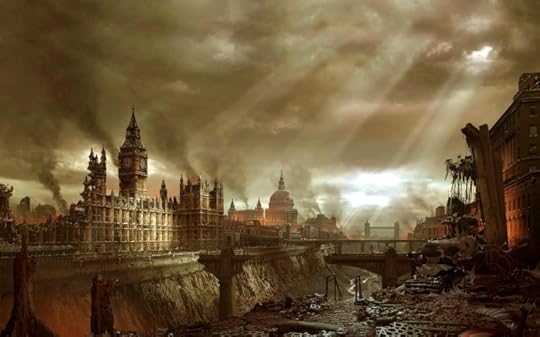 you sentimental for those pre-apocalyptic Christmas or Hanukah family dinners. The gaudy Christmas sweaters, forced socializing, awkward gift exchanges, drunken uncles and brawls with the in-laws seem positively quaint by comparison.
you sentimental for those pre-apocalyptic Christmas or Hanukah family dinners. The gaudy Christmas sweaters, forced socializing, awkward gift exchanges, drunken uncles and brawls with the in-laws seem positively quaint by comparison.
The memory of even the driest of turkey dinners can bring tears to your eyes when the last thing you’ve eaten was of the road kill variety. But, if you find yourself spending this holiday season in a post-apocalyptic world, you may as well try to make the most of it. To help you do just that, I’ve compiled this:
Survival Guide for the Post-Apocalyptic Holidays
You know how the holidays pre-apocalypse used to screw with everybody’s heads? Now, just be happy that you’ve survived. Let bygones be bygones. Let old family feuds—especially if you don’t have much family left—go by the wayside. If you’ve formed an alternative family unit in a parallel universe, take this opportunity to forge an even stronger bond. You want to make sure that your new relations really have your back and aren’t targeting it. And remember, sometimes a person who starts out as an enemy turns into a lifelong friend—just ask Malja about Fawbry.
Be thankful for what you have, however little it may be…and that’s not necessarily a bad thing. Think about it, you get to take a break from the stress and expense of buying gifts, traveling great distances, chitchat with distant relatives, and no more fruitcake! Although, I wouldn’t be surprised if fruitcake actually survived untouched no matter how hungry survivors are after the Devastation.
Don’t spend the holidays alone…Seriously, there’s safety in numbers and you’ll want to take turns standing watch to make sure that no uninvited guests crash your festive gathering. It’s probably smart that you take precautions not to attract too much attention so find the nearest cave or burned-out car in which to throw your party.
You’ll also want to keep noise at a minimum and keep the lighting ambient. If you’re fortunate to have a magician guest like Tommy in attendance, let him handle the lights and you may even get a real holiday light show.
When your post-apocalyptic host says, “your presence is your present” they are probably just being polite. Bringing a gift is especially welcome when resources are scarce. Any sort of weaponry would be a big hit—a new crossbow perhaps, or, if you really want to impress that special someone, a gun with bullets to spare guarantees an appreciative response. For the kiddies, a real ball will put a smile on their grubby little faces. It’s much more fun to play kickball with than the skulls of their departed friends. And, in case you’re not up to snuff on post-apocalyptic etiquette, you should know that a lump of coal makes a perfectly lovely hostess gift.
Whatever you do, if you get a good shot, don’t spare Santa if you catch a glimpse of him crossing the midnight sky. Sure, he’s delivering packages to all the good girls and boys…but, just think about the bounty if you make a direct hit! His sled. All of those tasty reindeer. You and your tribe could feast for months and open all the gifts to share or barter. Who knows? You may even be able to escape to a parallel universe on the blades of Santa’s sleigh. That would be a Happy Christmas to all and to all a goodnight, indeed!
If you’re not lucky enough to take Santa out but manage to pick off a reindeer, it’s obvious what’s for dinner (sorry kids). When the holiday festivities are over, don’t hang around waiting for non-existent leftovers. Pack up your camp, figure out your next move and hit the road before any one gets a whiff of your once-flying delicacy. Oh, and about that reindeer, if it happens to have come equipped with a glowing red nose, you’re not going to want to leave that behind. You can always use an additional light source.
Horrific Holiday Stories of Your Own?
If you’ve got any especially horrific holiday memories of your own, please feel free to share. I’m happy to commiserate…if you’ve visited my blog before, you know what to do. Leave a comment down there (imagine my fingers pointing toward the section below where the comments go).
The post Survival Guide for the End of the World Holiday appeared first on Stuart Jaffe.
Survival Guide for the Post-Apocalyptic Holiday
The holidays can be a stressful time under the best of circumstances. But, when you’re running for your life, foraging for food, trying to escape from Zombies, dodging guitar-playing assassins, or simply playing dead to avoid notice, your stress levels are stratospheric. Kind of makes you sentimental for those pre-apocalyptic Christmas or Hanukah family dinners. The gaudy Christmas sweaters, forced socializing, awkward gift exchanges, drunken uncles and brawls with the in-laws seem positively quaint by comparison.
you sentimental for those pre-apocalyptic Christmas or Hanukah family dinners. The gaudy Christmas sweaters, forced socializing, awkward gift exchanges, drunken uncles and brawls with the in-laws seem positively quaint by comparison.
The memory of even the driest of turkey dinners can bring tears to your eyes when the last thing you’ve eaten was of the road kill variety. But, if you find yourself spending this holiday season in a post-apocalyptic world, you may as well try to make the most of it. To help you do just that, I’ve compiled this:
Survival Guide for the Post-Apocalyptic Holidays
You know how the holidays pre-apocalypse used to screw with everybody’s heads? Now, just be happy that you’ve survived. Let bygones be bygones. Let old family feuds—especially if you don’t have much family left—go by the wayside. If you’ve formed an alternative family unit in a parallel universe, take this opportunity to forge an even stronger bond. You want to make sure that your new relations really have your back and aren’t targeting it. And remember, sometimes a person who starts out as an enemy turns into a lifelong friend—just ask Malja about Fawbry.
Be thankful for what you have, however little it may be…and that’s not necessarily a bad thing. Think about it, you get to take a break from the stress and expense of buying gifts, traveling great distances, chitchat with distant relatives, and no more fruitcake! Although, I wouldn’t be surprised if fruitcake actually survived untouched no matter how hungry survivors are after the Devastation.
Don’t spend the holidays alone…Seriously, there’s safety in numbers and you’ll want to take turns standing watch to make sure that no uninvited guests crash your festive gathering. It’s probably smart that you take precautions not to attract too much attention so find the nearest cave or burned-out car in which to throw your party.
You’ll also want to keep noise at a minimum and keep the lighting ambient. If you’re fortunate to have a magician guest like Tommy in attendance, let him handle the lights and you may even get a real holiday light show.
When your post-apocalyptic host says, “your presence is your present” they are probably just being polite. Bringing a gift is especially welcome when resources are scarce. Any sort of weaponry would be a big hit—a new crossbow perhaps, or, if you really want to impress that special someone, a gun with bullets to spare guarantees an appreciative response. For the kiddies, a real ball will put a smile on their grubby little faces. It’s much more fun to play kickball with than the skulls of their departed friends. And, in case you’re not up to snuff on post-apocalyptic etiquette, you should know that a lump of coal makes a perfectly lovely hostess gift.
Whatever you do, if you get a good shot, don’t spare Santa if you catch a glimpse of him crossing the midnight sky. Sure, he’s delivering packages to all the good girls and boys…but, just think about the bounty if you make a direct hit! His sled. All of those tasty reindeer. You and your tribe could feast for months and open all the gifts to share or barter. Who knows? You may even be able to escape to a parallel universe on the blades of Santa’s sleigh. That would be a Happy Christmas to all and to all a goodnight, indeed!
If you’re not lucky enough to take Santa out but manage to pick off a reindeer, it’s obvious what’s for dinner (sorry kids). When the holiday festivities are over, don’t hang around waiting for non-existent leftovers. Pack up your camp, figure out your next move and hit the road before any one gets a whiff of your once-flying delicacy. Oh, and about that reindeer, if it happens to have come equipped with a glowing red nose, you’re not going to want to leave that behind. You can always use an additional light source.
Horrific Holiday Stories of Your Own?
If you’ve got any especially horrific holiday memories of your own, please feel free to share. I’m happy to commiserate…if you’ve visited my blog before, you know what to do. Leave a comment down there (imagine my fingers pointing toward the section below where the comments go).
The post Survival Guide for the Post-Apocalyptic Holiday appeared first on Stuart Jaffe.
December 12, 2013
The Way of the Blade Takes Post-Apocalyptic Fantasy to a New Realm
If you’re looking for Xena: The Warrior Princess meets Mad Max then The Majla Chronicles are for you. The ass-kicking, “Viper”-wielding (more about that later) heroine, Malja, is on the war path again in The Way of the Blade, the fourth book in my post-apocalyptic fantasy fiction series. Today is the big release! I first introduced you to Malja in The Way of the Black Beast setting the stage for the magic, murder, and mystery that characterizes the series. Brandi Salazar of Fictitious Chronicle writes that Book One had her “hooked from the opening line” and was “blown away by the detail and mesmerized by the characters … I think I found myself a new favorite author!”
A Little Backstory From a Parallel Universe
I was thrilled when Books Two and Three, The Way of the Sword and Gun and The Way of the Brother Gods, respectively, garnered similar reactions from post-apocalyptic fantasy fiction readers. The first three books in The Malja Chronicles take place in a parallel universe on the planet, Corlin. Pre-apocalypse, magic ran the planet. Post-apocalypse, magic isn’t something you want to brag about. Malja was kidnapped as child by two powerful magicians who raised her (partly), and not only does she have some serious daddy issues, she despises magic. Hers is a quest for vengeance and her weapon of choice is a sickle-shaped sword she’s named Viper.
Something about Malja has struck a chord with readers, and I love telling her story. She’s one of my favorite characters to write—I often liken her to a female “Conan the Barbarian” or, for my younger readers, she’s got some Katniss from The Hunger Games in her, as well. Although Malja is a cold-blooded killer, she also has a conscience and forms meaningful personal attachments. She is a multi-dimensional figure with real-life vulnerabilities and invulnerabilities, qualities that are truly put to the test in The Way of the Blade.
The Way of Blade finds Malja Leaving Her Post-Apocalyptic Universe
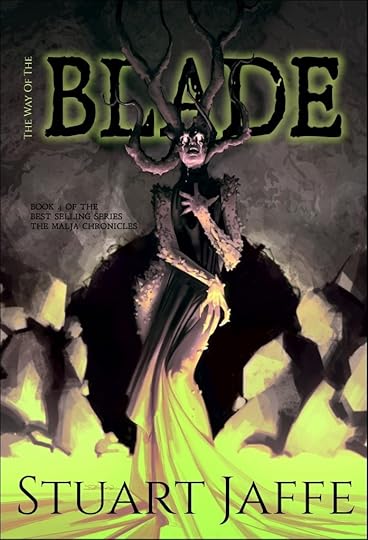
The Way of the Brother Gods closes with Malja having stepped through a portal to another parallel world. She has one goal in mind—find others like her (they call themselves Gate). Like her, they all wear the same curious garment — the do-kha, a unique suit with unique abilities — you’ll have to read the book to discover those. What Malja doesn’t know is where to find Gate because her home planet had been destroyed long ago and the remaining Gate are scattered throughout the many parallel universes. When she exits Corlin only to discover a world ravaged by a civil war, she is compelled to stop the madness before other innocent lives are lost.
Now, in the company of her two closest friends, for whom she serves as a sort of surrogate mother, Malja seeks to unite a divided world while searching for her own—efforts that may destroy both at the same time. Caught between those she loves and that which she desires most, Malja will have to risk everything –friendships, lives, even her chances to get home – in order to save it all.
How would you like to hear more?
As I always do with the release of my books, this week’s installment of my podcast The Eclectic Review features a reading from the opening chapter. If you’d like to hear me read you a story, simply click:
[http://traffic.libsyn.com/eclectic/TER-Show_357-Malja_and_the_Shill.mp3]
Already Convinced?
Take a trip to the universe known as Amazon.com by following this link
[http://www.amazon.com/dp/B00H0GO8G4]
I’d sure like to hear your thoughts, questions or impressions of The Way of Blade. If you’ve visited my blog before, you know what to do. Leave a comment down there (imagine my fingers pointing toward the section below where the comments go).
The post The Way of the Blade Takes Post-Apocalyptic Fantasy to a New Realm appeared first on Stuart Jaffe.
December 5, 2013
7 Reasons to Read Post-Apocalyptic Fantasy Fiction
I have a tagline that I use in my newsletter—Fantasy Knows No Bounds. That pretty much sums up why I love writing post-apocalyptic and fantasy fiction and any genre-blending permutations of the two. Science-fiction author Alan Dean Foster described fantasy as the “literature of the impossible” and I think his definition is about as good as it gets. When I write, I tread the ground between what is and what could be.
Creating anything is like a drug. But, the “world-building” inherent in writing post-apocalyptic fantasy fiction takes the high to exponentially greater heights. As an author, I get a real kick out of creating magical worlds for my readers to visit and explore—it’s just plain fun. And, the massive popularity of the post-apocalyptic and fantasy genres leads me to believe that readers find it fun, too. If you’re among the few who have yet to get lost in this fantastical brand of fiction, I’ve come up with 7 compelling reasons for you to open up a new sort of book and, perhaps, your mind.

7 Reasons to Read Post-Apocalyptic Fantasy Fiction
1. For the great escape – We live in a technologically advanced era, just the sort of age that many early Science-Fiction writers imagined. We have cell phones and laptops more powerful than anything imagined on Star Trek. Hell, we can even wear them on our wrists. We can travel anywhere in the world within hours. It can be overwhelming. Some forms of fantasy fiction allow readers to time travel to a romanticized world that seems simpler than ours today where people travel by horse or on foot—no futuristic trains, planes or automobiles. Conflicts are resolved definitively by the sword or hand-to-hand combat. Problems are overcome with magic. Other fantasy alters the tech of our time to become better, magical, or simply different in a fresh (and, hopefully, exciting) way. It’s an escape from our over-stressed hi-tech lives.
2. To learn survival skills – If you read or watch the news, you may see our world as a frightening, uncertain place. Reading post-apocalyptic fiction permits readers a measure of control between the pages of a book. Stories about survival after devastation—whether from chemical, biological, or nuclear warfare; natural disasters; or plague and disease—restore faith in the human condition and our resourcefulness. We can be voyeurs without actually having to scavenge for food, huddle around a fire, out run marauding gangs, or fight to overthrow a despotic government. By putting ourselves in the character’s shoes, we challenge our own ability to survive adversity.have cell phones and laptops more powerful than anything imagined on Star Trek. Hell, we can even wear them on our wrists. We can travel anywhere in the world within hours. It can be overwhelming. Some forms of fantasy fiction allow readers to time travel to a romanticized world that seems simpler than ours today where people travel by horse or on foot—no futuristic trains, planes or automobiles. Conflicts are resolved definitively by the sword or hand-to-hand combat. Problems are overcome with magic. Other fantasy alters the tech of our time to become better, magical, or simply different in a fresh (and, hopefully, exciting) way. It’s an escape from our over-stressed hi-tech lives.
3. To explore alternative spirituality – I think religion or some sort of spirituality is a must-have when creating a fictional world (even if it ultimately is a form of atheism). For example, my Malja Chronicles deal with religions that have existed before and after the Devastation, and include different sects of similar beliefs, and how they crash together. In our real world with looming threats of religiously motivated terrorism, “Doomsday Preppers” and speculation about the Mayan Apocalypse, many of us are searching for a set of spiritual beliefs to help us make sense of things.
4. Because it’s liberating – Much post-apocalyptic fantasy, or even science-fiction, envisions a world where all the pressures and rules that we live under go away. Yes, there are new pressures (how will I eat tonight?) but there is an assumed great sense of freedom (why even brush my hair?) that would come when all form of law is abolished. The apocalypse wipes away some or all of what we’re familiar with, allowing a new setting to be built upon the ashes of the old. The possibility of a pure utopian existence is freeing for fans of the fantasy genre.
5. They give you hope – Reading post-apocalyptic fantasy fiction lends credence to the notion that an alternative socio-political universe is possible. In The Malja Chronicles, as another side theme, I take a look at the viability of anarchy and point out that it pretty much will only exist when there are few people spread far apart. The moment people congregate together, rules get established and, inevitably, a hierarchy emerges. Sometimes it takes just one strong character, like the Hunger Games’ heroine Katniss, who stands up against tyranny to restore hope in a soulless world.
6. Everybody loves a good allegory - In a post-apocalyptic setting, everything is changing and, as the characters are challenged, they find out who they really are. Readers go through this process along with them and their own mettle is tested as well. Surviving after the Devastation is a metaphor for growing up, an incredibly powerful one, and young readers can see their own internal struggles in the grand chaos of the story’s heroes and heroines.
7. Because everyone else is doing it –I’m not an advocate for conformity. But just because everybody else is doing something, doesn’t mean you’re conforming if you want to do it, too – assuming the reason you want to do it has nothing to do with what everybody else is doing! Catch all that? And when it comes to reading post-apocalyptic fantasy fiction (or any bit of our geek culture), I say get on board. You’ll quickly discover a large community of like-minded readers and you’ll finally understand what everybody else is talking about.
Why do you read post-apocalyptic fantasy fiction? Or, why not?
Tor.com editor Teresa Nielsen-Hayden has written, “If you ask 20 different readers why they read, they will all be right.” I couldn’t agree more. What are your reasons for reading post-apocalyptic fantasy fiction? I’m interested to know…and, if you’ve visited my blog before, you know what to do. Leave a comment down there (imagine my fingers pointing toward the section below where the comments go).
The post 7 Reasons to Read Post-Apocalyptic Fantasy Fiction appeared first on Stuart Jaffe.

